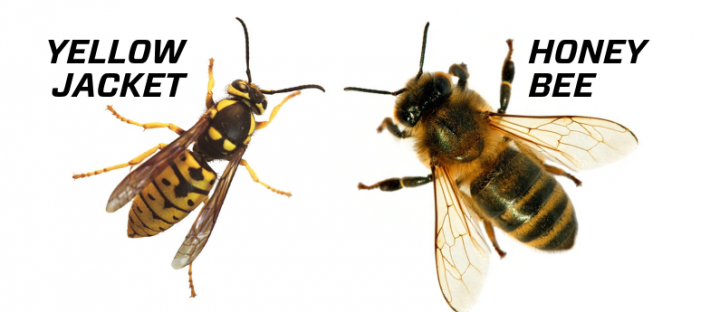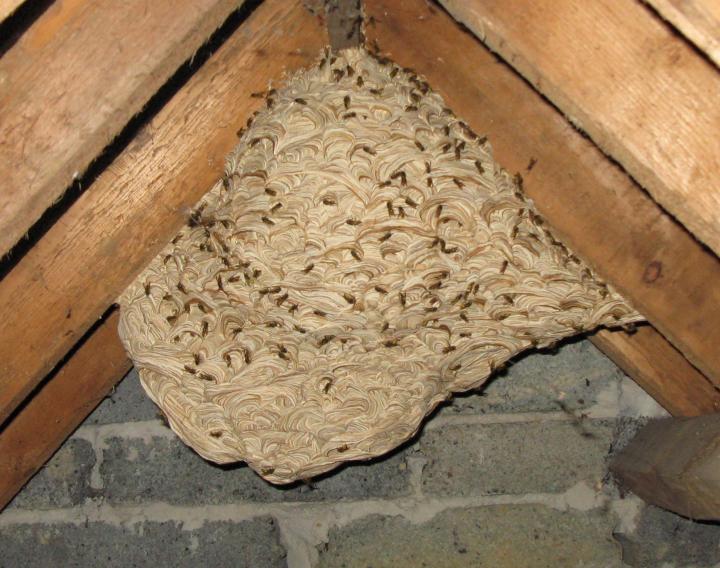
Treating Yellow Jacket Stings and How to Deal With Their Nests
The Almanac Garden Planner - Use It Free for 7 Days!
Plan your 2025 garden with our award-winning Garden Planner.

Fall Flowers and Foliage
Fall Vegetable Gardening
Fall Garden Cleanup
Garden Soil Preparation
Fall Nature
ADVERTISEMENT
Nobody said a word here yet about these critters loving fallen apples. I leave some apples on the ground for the little darlings to feast on. While I pick up my share of the apples to make vinegar with they have their share...the ones that are already broke open for them. They never bother me when I check each fallen apple to decide whether to keep it or toss it aside for the flying critters.
I was walking in my woods in Townshend VT in rather thick small saplings, was recently cut timber. When I was attacked by black white tail hornets away and in the clear. I got out of there quickly, not knowing what way to run, just run. Some time later when the leaves dropped I saw a large paper wasp nest in a small tree, no wasps then, or were in hibernation. It appeared that I was about 50 feet from the nest, no way near and couldn't see it, but got nailed. Thankfully I'm not allergic to the stings. Wasps / Hornets are unpredictable and I've had my share of episodes while being innocent. not molesting. But, I've also had my pay back times in late evenings when they are in bed. I haven't seen any mention of this type of wasp which is reportedly aggressive.
Some people save those paper nests for decoration.
I usually have out grape jelly more in the spring for the Orioles that stop by. Towards June and July it's the wasps that take over.
This is what happens:
The Yellow Jacket Wasps
By Mary J Williams ©
I feed the birds
And sometimes it’s jelly
Grape jelly for Orioles
A lot goes into their belly
This year the honeybees
Were flying about
They went to the dishes
Passed info to the scout
More honeybees came
I kept the dishes full
Went through a big jar
And that is no bull
Alas the wasps came then
The temperatures were dropping
The honeybees left
But wasps weren’t stopping
The thing I noticed most
The wasps weren’t as smart
They also used the birdbath
But they weren’t as careful from the start
They went to the edge
Put their head down in
Sometimes slipped and fell
That’s where the story begins
I go to fill the birdbath up
I see a wasp upside down
You silly little wasp
I say with a frown
Some others are buzzing around
But that didn’t stop me
Sometimes got them out with the spray
A leaf or a tool, but never let them be
I saved as many as I could
I know some must have drowned
It wasn’t my fault
I saved the ones I found
I think the ones that were in trouble
Gave the word to one and all
Do not hurt that person
She is saving us from our falls!
I was stung by a yellow jacket at a picnic. The only thing available were the plants and weeds around me. I chewed up some broadleaf plantain and covered the area with it. The sting was immediately soothed. Good to know in a pinch.
Interesting information about the nest being empty during the Winter; thanks~(I just moved intoa a house with some under the eaves; I'll wait until they leave; In late fall, the workers, the drones, and the queen herself will all leave the nest and die. Only the mated queens survive, burrowing into leaf litter and hibernating in suspended animation until spring. ty
I feed yellow jackets! Mostly honey, but sometimes molasses or cooked meat or fish. I have had over 75 at the feeding place(on a table by the back door) and they aren't agressive. I know they keep mosquitoes and black flys away.... Some of them get to 'know' me and will come in the house and 'buzz' me to put out more honey. Butterflys 'whack' them with their wings and seem to be the only thing that the yellow jackets are respectful of. I have never been stung since I started feeding them and they often crawl on my hands when I put out stuff. They like oranges but won't touch lemons!
Are you positively CERTAIN those are yellowjackets? I could see honeybees, maybe, but yellowjackets? I live and let live, but no matter what, the yellowjacket always has a bad attitude. Even if I'm not threatening. I've been stung by a yellowjacket and that is the most long lasting, painful sting ever.
You truly said that RIGHT!! I JUST GOT STUNG APPROXIMATELY 10 OR MORE TIMES WHILE MOWING MY FRNT LAWN WITH A PUSH MOWER,IVE ALREADY MOWED THIS AREA ONCE THIS YEAR & HAD NO SIGN OF YELLOW JACKETS OR SEEN ANY BUT IT HASNT RAINED HERE LAST COUPLE MONTHS & JUST HAS RAINED SO HERE I GO MOWING AND "" BAM ,BAM ,BAM BEFORE I KNEW WHAT IN WORLD WAS GOING ON "" I'M RUNNING LIKE A CHEETAH "" I DONE GOT "TAGGED"" MANY TIMES AND WHEN I "" DONT KNOW REALLY"" FELT THEY HAD QUIT I STOPPED & ATTEMPTED TO COLLECT MYSELF AND FIGURED OUT WHAT HAD JUST TAKEN PLACE ,NO MORE THAN 3 MINUTES PASSED AND I TELL YOU I HAD THE WORST EVER BURNING PAINS I CANNOT KNOW OR FELT BEFORE IN MY WHOLE LIFE TO DATE !! THEM CRITTERS" Yellow jackets " Instill Quite a painful enduring "" lasting"" very painful"" Worst I've ever had this far "" sting !! 3 hours now & I'm in just as much pain if not more than from first being attacked, I've treated stings with vinegar & made a paste of baking soda & I gotta say I not think it has helped me at all !! I finally went down to creek next to my place & just layed down in the cool flowing water for more than half an hour or so !! Maybe time elapsed on the bee venom?? Anywho that creeks cool water I will forever SAY IS NOTHING SHORT OF BEING "' A MIRACLE"!! STAY SAFE FOLKS !! REMEMBER, YELLOW JACKETS AINT NO JOKE !! THEM THAR FLYING DEVILS ARE "" MEAN I TELL YA & UNFORGIVING ESPECIALLY IN THE PAIN DEPARTMENT!!!
We use to have jackets build several nests in our open garage, but read that you just hang a brown paper bag with stuffing in it and the jackets think it is a hornet nest and do not come around. So I did, and no jackets for several years. Think this one works!!
This is absolutely true. Wasps were constantly building nests on my back porch. After hanging a paper bag up, I have not had wasp nest for several years.












